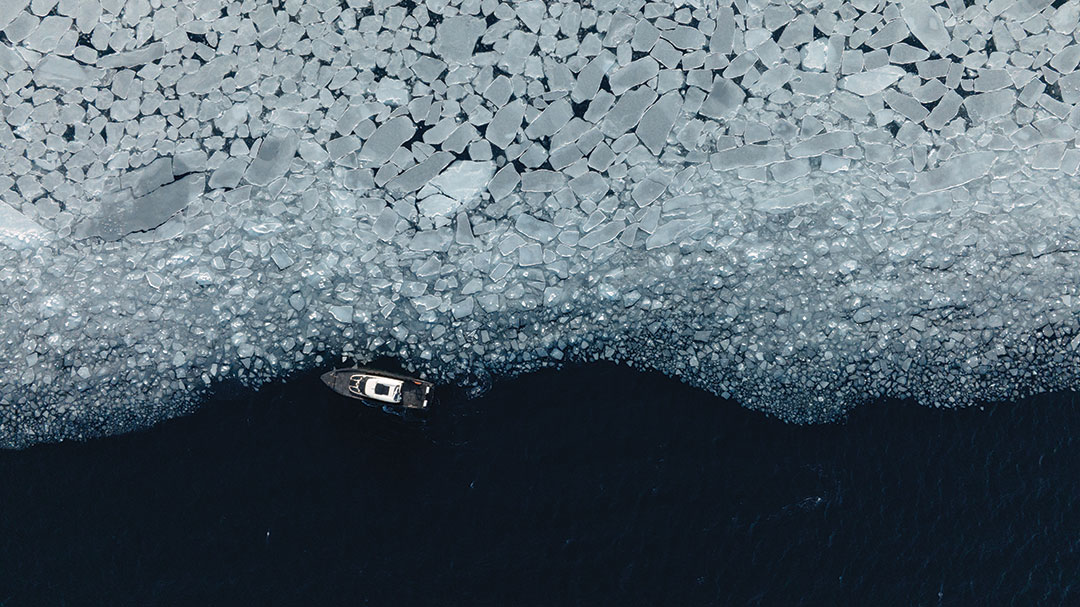
Tore Hoem looked across the vast fjord on a frigid Arctic afternoon on Svalbard, some 1,250 miles north of Oslo, Norway, and predicted the weather would hold.
“The sea looks OK,” said Hoem, the adventures director for tour company Hurtigruten Svalbard. “I don’t expect too much wind. We might have a bit of waves. Let’s see.”
Moments earlier, he guided Hurtigruten’s new Volvo Penta-powered hybrid tour boat Kvitbjorn away from the dock in Longyearbyen, the world’s northernmost town. About a dozen reporters and editors from the United States and Europe rode aboard the 48-foot Marell Boats M15 for its maiden tour across the fjord.
Electric motors noiselessly moved Kvitbjorn to the west at about 7 knots toward prime polar bear habitat. After pointing out some landmarks, Hoem warned he was about to accelerate.
“OK then, now we try with the diesels,” he said before pushing the vessel ahead to 25 knots.
Kvitbjorn was developed via a partnership between Volvo Penta, Marell Boats and Hurtigruten, the Norway-based cruise and tour operator. It is Hurtigruten’s first hybrid, and it is the first vessel with a complete Volvo Penta hybrid powerplant.
Perhaps even more noteworthy, however, is the financing model that facilitated the hybrid installation. Although Hurtigruten bought the vessel, Volvo Penta owns the hybrid driveline itself. It charges Hurtigruten a fee each month based on its usage.
This novel approach reduces the upfront cost associated with installing a hybrid propulsion system. It’s one of the avenues Volvo Penta is exploring to speed the adoption of low- and zero-emission propulsion.
“We want to nudge that discussion and see what there are for viable options moving forward,” said Johan Inden, president of Volvo Penta’s marine business unit.
Volvo Penta established a three-year pilot program with Marell and Hurtigruten to gain insights on the performance, resilience and life span of the hybrid system, along with other key metrics and data points. That time frame should also help Volvo Penta better understand whether the pay-as-you-use model, or another one like it, is possible.
“We want to learn things like, OK, now they are paying for the driveline and the service but they are buying the boat. Can we really separate that?” Inden said. “Does it work with insurance? Does it work with service? How do banks and leasing companies look at it?”
The life span of the battery bank in any hybrid system will vary from vessel to vessel. But the batteries will almost certainly wear out before the boat does. The Volvo Group has launched a new business unit, Volvo Energy, that is looking at how much batteries will be worth once they hit the end of their useful life.
“Residual values will be more important when you load more batteries onto your vessel because they are an asset that will depreciate over time,” Inden said. “We should be better at … understanding the value of batteries because that will determine what kinds of services we should offer. That is the kind of knowledge base we are trying to build up.”
Separately, the Volvo Group announced in August that it will build a battery plant in Sweden to support multiple business lines, including its marine unit. By 2030, the company aims for 35 percent of its sales to be electric. This transition will likely happen at different speeds across Volvo, which sells trucks, buses and construction equipment in addition to Volvo Penta’s marine and industrial power units.
“This ramp-up will require large volumes of high-performing batteries produced using fossil-free energy, and it is a logical next step for us to include battery production in our future industrial footprint,” said Martin Lundstedt, president and CEO of the Volvo Group.
Kvitbjorn easily cut through light chop en route to a waterway known as Isfjorden. The vessel passed Svalbard’s active shipping port, which exports coal to Germany for use in steelmaking, and the airport that connects the island with mainland Norway.
Svalbard is composed of four islands, the largest of which, Spitsbergen, is home to Longyearbyen and a handful of coal-mining settlements, most of which are abandoned. Longyearbyen is by far the largest community on Svalbard with about 2,400 residents. The surprisingly cosmopolitan town has a university, numerous hotels, restaurants and a well-stocked grocery store. There is even a brewery.
Roughly 125,000 tourists visit each year, many looking to see the northern lights during the long polar night when the sun never rises. The opposite occurs in the spring and summer, when darkness never comes. Snowmobiling and dogsledding are big winter draws, while hiking and ATV riding are popular in warmer months.
Svalbard is home to roughly 3,500 polar bears, and local law requires anyone venturing outside of Longyearbyen to carry a firearm for safety.
The aluminum-hulled Kvitbjorn is designed for high-speed performance in heavy seas — like those often found around Svalbard. It has seating for 12 passengers in three rows and is designed for a single operator. Its navigation package includes Garmin electronics, and it has a small cabin below deck with head and kitchenette.
The vessel — smaller than many American tour boats — is similar to a pilot boat or patrol boat in size and capability. Jonas Karnerfors, sales product manager for Volvo Penta, said the hybrid-electric powerplant could be applied to those and other commercial and recreational uses.
“We are collaborating with pilot associations, although many of them at this stage are asking for a fully electric solution,” he said during an interview in Svalbard. “But everything we learn from this project will be for fully electric as well as hybrid solutions. We need to be able to select the best solution for every user case.”
Kvitbjorn is equipped with Volvo Penta’s D4-320 DPI integrated propulsion system that directly pairs the engines with the drive units. Batteries capable of storing 100 kilowatt hours of electricity supply power to twin 70-kW (94 hp) motors. The package also uses Volvo Penta’s electric steering and throttle components.
The hybrid system offers three drive modes. Electric allows the vessel to operate on battery power, generating no engine noise or emissions. Kvitbjorn can travel up to 9 knots on electric power, albeit while using a lot of energy from the batteries. The electric motors also can be used to charge the batteries during transits.
Hybrid mode automatically operates the electric motors, diesel engines, or both systems in tandem based on the operator’s power demands. The system runs the diesels alone during high-speed voyages. But when the operator decelerates below 1,500 rpms, the diesels shut down and the electric motors take over, Karnerfors explained. Both systems operate together during rapid acceleration, bringing the vessel to plane faster.
A digital interface in the helm station displays critical data about the hybrid system, including speed, battery charge levels, fuel levels and engine temperatures. It also has a touchscreen setting that allows the operator to toggle between hybrid modes. Kvitbjorn has a range of 500 nautical miles and a top speed approaching 30 knots.
Hoem’s hunch about the weather was right: Outside of Longyearbyen, the sky was bright and sunny. He steered Kvitbjorn to the edge of the sea ice, roughly 20 nautical miles from Longyearbyen. The diesel engines automatically shut down as he eased back on the throttles, leaving the electric motors for propulsion.
The vessel was silent as the group gathered on the aft deck looking west toward glaciers and snowy mountain summits. Using binoculars, Hoem identified a track on a faraway mountain used by polar bears to slide down the slope. Minutes earlier he spotted a walrus swimming about a half-mile from the vessel.
“The glacier is often a highlight in itself,” he said, referring to two glaciers on either side of a mountain almost straight ahead.
Kvitbjorn is equipped with a virtual anchor, although it wasn’t necessary with the vessel beam-to a sheet of sea ice a half-inch thick. “I am actually surprised by the amount of sea ice,” Hoem said, “and that it is sticking around this long.”
It was time to return about 45 minutes later. The vessel moved noiselessly for a few minutes as Hoem steered away from the ice. The main engines roared to life as the vessel picked up speed en route to Longyearbyen.
Small icebergs now dotted the horizon, requiring Hoem to ease back on the engines. He dodged the floating ice like an airplane captain steering around thunderheads. Closer to Longyearbyen, the massive white domes of the Svalbard Satellite Station came into view.
After a few spins around the harbor, Hoem steered the vessel back into the dock using the joystick steering system. Paying tourists began arriving over the next few days, beginning in earnest the pilot program that could help nudge the maritime industry toward a greener future. •

